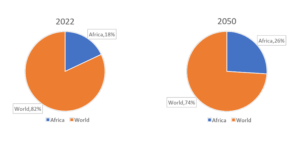
Macro trends encompass long-term tendencies that widely affect different spectrums of society, sometimes with economic, political, and cultural impacts. Th

Macro trends encompass long-term tendencies that widely affect different spectrums of society, sometimes with economic, political, and cultural impacts. They represent significant and lasting structural changes, with local and global consequences.
These trends are driven by a variety of factors and have effects on commodity markets. Check out the examples here of how macro trends can influence this sector:
Understanding macro trends is essential to anticipate imminent transformations and adapt to them. With that in mind, we´ve selected the main macro trends for commodity markets and will point out the role of risk management in this context. Continue reading to find out!
A combination of compelling factors is accelerating a major shift in the commodity paradigm. hEDGEpoint analysis highlights the main macro trends up to 2030. We explain how each of them could truly transform commodity markets in the coming years. Check it out below!
According to Digital 2022: Global Overview Report, more than 60% of the planet’s population is connected to the internet, reaching a mark of five billion people. The survey also indicated that almost 23% of global users access social networks in their professional activities. Currently, there are more than 22 billion connected devices globally. According to Statista, that number will rise to 50 billion by 2030.
Given this scenario, 90% of stock trades are already controlled by algorithms. The consequences of this reality are countless for commodity markets. One of them is more production efficiency through automation, with the application of advanced algorithms and data analysis aimed at optimizing operations.
Another transformation is happening in commerce and logistics, with the increased use of mobile devices that facilitate transactions in real time. Automated trading algorithms, artificial intelligence, and machine learning are increasingly employed to predict trends and manage risk. Technology also plays a crucial role in the discovery, exploration, and even extraction of commodities, using drones, satellites, and sensors that identify areas rich in resources.
These are top priorities for most countries. The deglobalization trend was further amplified by COVID-19 and the Ukraine War, two events that disrupted commodity supply chains and spurred inflation. In the medium term, it’s likely that food security difficulties will be reduced as new suppliers are found. Regarding climate and energy, there’s a strong tendency to adopt sustainable practices, which will increase the demand for renewable energies and strategies to minimize greenhouse gas emissions.
Since the beginning of the pandemic, we’ve seen a trend towards higher and more volatile prices, especially in energy markets. In Europe, for example, the increase in natural gas prices caused a liquidity crisis in the last 12 months. As new energy sources become available up to 2030, further price stabilization is likely, but we need to stay closely tuned.
With this volatility, commodity producers may suffer a direct impact on their revenues and profits, facing uncertainties related to their sales and input purchases. Investors also run the risk of facing difficulties in planning for the long term, with obstacles even to access credit due to instability. Supply chains and final product prices are likely to be affected if there are changes in supply and demand.
Combining the words Environmental, Social, and Governance, the term ESG is being applied by companies that are preparing plans to reduce or contain adverse environmental impacts. This is yet another important trend for all agents operating in commodity markets.
ESG transitions embody strategies that are part of broader organizational sectors. As a result, practices such as metal recycling, reductions in carbon emissions, and the guarantee of good working conditions in supply chains are being adopted. Governance is also imperative, with strict protocols and proper codes of conduct to ensure full compliance with laws and regulations.
By the end of the century, the world’s population is expected to reach a figure of 11 billion, with exponential growth in Africa and Asia. Life expectancy is increasing, with fewer children expected, especially in Western nations. The changes are also generational, with millennials and those who follow them driving the global economy through new preferences and ways of consuming.
All these aspects will directly affect the supply and demand of commodities, influencing the availability of resources, as well as the axis of influence for businesses linked to commodities, with Asia and Africa assuming a more central role in the markets.
hEDGEpoint analysis also highlights population growth in Asia and Africa, which will certainly increase demand for commodities in these regions, especially energy. The Energy Information Administration (EIA) projects an increase of almost 50% in world energy use by 2050, led by the rise of the Asian continent.
United Nations (UN) data indicates that the population of Africa will grow from 18% in 2022 to 26% by 2050, adding about 1.1 billion people to the world. Take a look at the comparison in the chart below:

Source: United Nations
In Asia, the estimated increase is 628 million people. New centers of urban growth are also emerging on these continents. Currently, 50% of the world’s population live in cities, while they consume ¾ of the world’s natural resources. In this scenario, it will be increasingly important to observe supply and demand dynamics, which could impact commodity markets.
hEDGEpoint: Strategic role in risk management
hEDGEpoint takes all these macro trends into account: We always follow what’s happening in the markets at both a local and global level. In this way, we’re able to outline business strategies that incorporate changes in society and define the best response for our company so we can offer the most appropriate hedging solutions to our customers.
Staying aware of all these trends is essential to devise more effective risk management tools capable of bringing security to your business. hEDGEpoint provides innovative hedging products, delivering valuable insights to clients. We seek to anticipate changes, by mapping trends and contributing to strategic decision-making.
Talk to a hEDGEpoint specialist today to find out more!

Rua Funchal, 418, 18º andar - Vila Olímpia São Paulo, SP, Brasil
Contato
(00) 99999-8888 example@mail.com
Section
Home
O que Fazemos
Mercado
Quem Somos
HUB
Blog
Esta página foi preparada pela Hedgepoint Schweiz AG e suas afiliadas (“Hedgepoint”) exclusivamente para fins informativos e instrutivos, sem o objetivo de estabelecer obrigações ou compromissos com terceiros, nem de promover uma oferta ou solicitação de oferta de venda ou compra de quaisquer valores mobiliários, commodity interests ou produtos de investimento.
A Hedgepoint e suas associadas renunciam expressamente a qualquer uso das informações contidas neste documento que direta ou indiretamente resulte em danos ou prejuízos de qualquer natureza. As informações são obtidas de fontes que acreditamos serem confiáveis, mas não garantimos a atualidade ou precisão dessas informações.
O trading de commodity interests, como futuros, opções e swaps, envolve um risco substancial de perda e pode não ser adequado para todos os investidores. Você deve considerar cuidadosamente se esse tipo de negociação é adequado para você, levando em conta sua situação financeira. O desempenho passado não é necessariamente indicativo de resultados futuros. Os clientes devem confiar em seu próprio julgamento independente e/ou consultores antes de realizar qualquer transação.
A Hedgepoint não fornece consultoria jurídica, tributária ou contábil, sendo de sua responsabilidade buscar essas orientações separadamente.
A Hedgepoint Schweiz AG está organizada, constituída e existente sob as leis da Suíça, é afiliada à ARIF, a Associação Romande des Intermédiaires Financiers, que é uma Organização de Autorregulação autorizada pela FINMA. A Hedgepoint Commodities LLC está organizada, constituída e existente sob as leis dos Estados Unidos, sendo autorizada e regulada pela Commodity Futures Trading Commission (CFTC) e é membro da National Futures Association (NFA), atuando como Introducing Broker e Commodity Trading Advisor. A Hedgepoint Global Markets Limited é regulada pela Dubai Financial Services Authority. O conteúdo é direcionado a Clientes Profissionais e não a Clientes de Varejo. A Hedgepoint Global Markets PTE. Ltd está organizada, constituída e existente sob as leis de Singapura, isenta de obter uma licença de serviços financeiros conforme o Segundo Anexo do Securities and Futures (Licensing and Conduct of Business) Act, pela Monetary Authority of Singapore (MAS). A Hedgepoint Global Markets DTVM Ltda. é autorizada e regulada no Brasil pelo Banco Central do Brasil (BCB) e pela Comissão de Valores Mobiliários (CVM). A Hedgepoint Serviços Ltda. está organizada, constituída e existente sob as leis do Brasil. A Hedgepoint Global Markets S.A. está organizada, constituída e existente sob as leis do Uruguai.
Em caso de dúvidas não resolvidas no primeiro contato com o atendimento ao cliente (client.services@hedgepointglobal.com), entre em contato com o canal de ouvidoria interna (ombudsman@hedgepointglobal.com – global ou ouvidoria@hedgepointglobal.com – apenas Brasil) ou ligue para 0800-8788408 (apenas Brasil).
Integridade, ética e transparência são valores que guiam nossa cultura. Para fortalecer ainda mais nossas práticas, a Hedgepoint possui um canal de denúncias para colaboradores e terceiros via e-mail ethicline@hedgepointglobal.com ou pelo formulário Ethic Line – Hedgepoint Global Markets.
Nota de segurança: Todos os contatos com clientes e parceiros são realizados exclusivamente por meio do nosso domínio @hedgepointglobal.com. Não aceite informações, boletos, extratos ou solicitações de outros domínios e preste atenção especial a variações em letras ou grafias, pois podem indicar uma situação fraudulenta.
“Hedgepoint” e o logotipo “Hedgepoint” são marcas de uso exclusivo da Hedgepoint e/ou de suas afiliadas. O uso ou reprodução é proibido, a menos que expressamente autorizado pela HedgePoint.
Além disso, o uso de outras marcas neste documento foi autorizado apenas para fins de identificação. Isso, portanto, não implica quaisquer direitos da HedgePoint sobre essas marcas ou implica endosso, associação ou aprovação pelos proprietários dessas marcas com a Hedgepoint ou suas afiliadas.
aA Hedgepoint Global Markets é correspondente cambial do Ebury Banco de Câmbio, de acordo com a resolução CMN Nº 4.935, DE 29 DE JULHO DE 2021, Artigo 14 do Banco Central do Brasil (BACEN).
Para mais informações sobre nosso parceiro, serviços disponíveis, atendimento e ouvidoria, acesse o link a seguir: https://br.ebury.com/